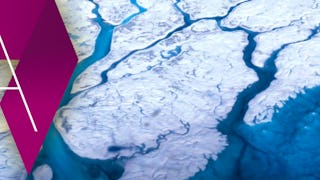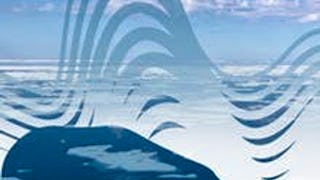In this course you will first learn about the Arctic as a geographic region, the peoples the Arctic, and the long history of Arctic settlement and exploration. Attention then turns to key features of the Arctic environment – its climate and weather, features of the ocean, sea ice, lands and the Greenland Ice Sheet, and some of the rapid changes being observed.



Intro to the Arctic
This course is part of Arctic Meltdown Specialization

Instructor: Mark C. Serreze
2,347 already enrolled
Included with 
(34 reviews)
Recommended experience
What you'll learn
Appreciate the long history of the Arctic and its peoples
Recognize and recall the physical geography of the Arctic, including major features of the Arctic Ocean and Arctic lands
Describe the key climate and environmental elements of the Arctic
Details to know

Add to your LinkedIn profile
5 assignments
See how employees at top companies are mastering in-demand skills

Build your subject-matter expertise
- Learn new concepts from industry experts
- Gain a foundational understanding of a subject or tool
- Develop job-relevant skills with hands-on projects
- Earn a shareable career certificate


Earn a career certificate
Add this credential to your LinkedIn profile, resume, or CV
Share it on social media and in your performance review

There are 5 modules in this course
With so much going on in the Arctic, it can be a challenge to decide where to start. This week we provide an overview of the Arctic as a geographic region, followed by some of the pronounced changes unfolding in the North, such as rapid warming, the shrinking sea ice cover and thawing permafrost. History provides context. As such, we need to explore how we built our knowledge of the Arctic, starting with the sometimes tragic ends of early explorers searching for the fabled Northwest Passage, then moving through the Cold War and into the present.
What's included
5 videos1 reading1 assignment1 discussion prompt
To understand the Arctic system and the profound changes taking place, we need to become familiar with some of the basic climate drivers and features of the region, starting with solar energy, polar night, and the midnight sun. Attention then turns to patterns of temperature, precipitation and cloudiness and how they vary across the Arctic.
What's included
4 videos1 assignment
A defining feature of the Arctic is that it is a largely ice-covered ocean surrounded by land. While by area, it is the smallest of the world's oceans, it is by far the most interesting of them all. This week, we focus on the Arctic Ocean starting with some basics - its shallow seas and deep basins, and then move on to discuss the Arctic Ocean's floating ice cover. As we will learn, the Arctic sea ice cover, which ranges from a thin veneer to more than five meters thick, grows and shrinks with the seasons. The ice cover is in near constant motion, with ice flows squeezing together to form pressure ridges and pulling apart to form leads. Unlike other oceans, the Arctic Ocean has an intriguing vertical structure, with fresh cold water at the top and warm salty water below.
What's included
4 videos1 assignment
The Arctic lands are much more than treeless, windswept tundra. Greenland, the largest island in the world, is mostly covered by an ice sheet up to 3,200 meters thick. It is losing mass and contributing to sea level rise. While much of the Arctic lands are indeed covered by tundra, the Arctic is also home to large swaths of forest and extensive mountain ranges. Some very large rivers drain into the Arctic Ocean, discharging massive amounts of fresh water. Almost all of the Arctic lands are covered with perennially frozen ground called permafrost. However, this permafrost is now thawing, changing the landscape and putting infrastructure at risk.
What's included
4 videos1 assignment
While blizzards, whiteouts and extreme winter cold are a part of living in the Arctic, summer thunderstorms are common over land. Arctic weather is varied and fascinating, but the Arctic region plays a bigger role in the climate system by helping to shape weather patterns across the Northern Hemisphere. Arctic weather and climate is also shaped by teleconnections, such as the North Atlantic Oscillation, that link weather conditions across widely separated locations. Another important framework for understanding the Arctic is its energy budget, which refers to the flows of energy into and out of the Arctic and between the atmospheric ocean.
What's included
4 videos1 assignment
Instructor

Offered by
Explore more from Environmental Science and Sustainability


University of Alberta


University of Colorado Boulder


École Polytechnique Fédérale de Lausanne


University of Alberta
Why people choose Coursera for their career




Learner reviews
34 reviews
- 5 stars
85.29%
- 4 stars
8.82%
- 3 stars
2.94%
- 2 stars
0%
- 1 star
2.94%
Showing 3 of 34
Reviewed on Jun 1, 2022
I learned a great deal about the Arctic and enjoyed the lectures.
Reviewed on Feb 21, 2025
A wonderful introduction to the Arctic and its climate which have a deep connection to the climate at the global scale.
Reviewed on Apr 9, 2025
This is a fantastic course. Easy to follow the logic but it is jam packed with information.

Open new doors with Coursera Plus
Unlimited access to 10,000+ world-class courses, hands-on projects, and job-ready certificate programs - all included in your subscription
Advance your career with an online degree
Earn a degree from world-class universities - 100% online
Join over 3,400 global companies that choose Coursera for Business
Upskill your employees to excel in the digital economy
Frequently asked questions
Access to lectures and assignments depends on your type of enrollment. If you take a course in audit mode, you will be able to see most course materials for free. To access graded assignments and to earn a Certificate, you will need to purchase the Certificate experience, during or after your audit. If you don't see the audit option:
The course may not offer an audit option. You can try a Free Trial instead, or apply for Financial Aid.
The course may offer 'Full Course, No Certificate' instead. This option lets you see all course materials, submit required assessments, and get a final grade. This also means that you will not be able to purchase a Certificate experience.
When you enroll in the course, you get access to all of the courses in the Specialization, and you earn a certificate when you complete the work. Your electronic Certificate will be added to your Accomplishments page - from there, you can print your Certificate or add it to your LinkedIn profile. If you only want to read and view the course content, you can audit the course for free.
If you subscribed, you get a 7-day free trial during which you can cancel at no penalty. After that, we don’t give refunds, but you can cancel your subscription at any time. See our full refund policy.
More questions
Financial aid available,

